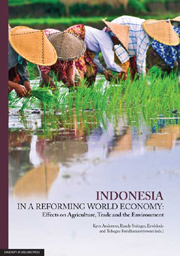Book contents
- Frontmatter
- Contents
- List of tables, figures and boxes
- FIGURES
- Acronyms
- Preface
- List of contributors
- 1 Introduction
- 2 Effects of growth, its interruption, and the Uruguay Round on Indonesian agriculture
- 3 Effects of AFTA and APEC trade policy reforms on Indonesian agriculture
- 4 Trade liberalisation and soil degradation in Indonesia
- 5 Will the Uruguay Round and APEC reforms harm air and water quality in Indonesia?
- 6 Impacts of agricultural protection growth at home and the WTO's Doha Round on Indonesian agriculture
- 7 Effects of agricultural policy reform on household and regional income distribution in Indonesia
- 8 Effects of farm policy reform on Indonesia's secondary food crops
- 9 Effects of agricultural policy reform in Indonesia on its food security and environment
- 10 Impacts of trade policy reform on income distribution and poverty in Indonesia
- APPENDIX 1 The WAYANG Model of the Indonesian economy
- APPENDIX 2 The GTAP Model and database
6 - Impacts of agricultural protection growth at home and the WTO's Doha Round on Indonesian agriculture
Published online by Cambridge University Press: 05 June 2012
- Frontmatter
- Contents
- List of tables, figures and boxes
- FIGURES
- Acronyms
- Preface
- List of contributors
- 1 Introduction
- 2 Effects of growth, its interruption, and the Uruguay Round on Indonesian agriculture
- 3 Effects of AFTA and APEC trade policy reforms on Indonesian agriculture
- 4 Trade liberalisation and soil degradation in Indonesia
- 5 Will the Uruguay Round and APEC reforms harm air and water quality in Indonesia?
- 6 Impacts of agricultural protection growth at home and the WTO's Doha Round on Indonesian agriculture
- 7 Effects of agricultural policy reform on household and regional income distribution in Indonesia
- 8 Effects of farm policy reform on Indonesia's secondary food crops
- 9 Effects of agricultural policy reform in Indonesia on its food security and environment
- 10 Impacts of trade policy reform on income distribution and poverty in Indonesia
- APPENDIX 1 The WAYANG Model of the Indonesian economy
- APPENDIX 2 The GTAP Model and database
Summary
There is a mixture of views within East Asia about agricultural trade reform and hence about its inclusion in the Uruguay Round agreements and subsequent negotiations under the World Trade Organization (WTO). On the one hand, governments in the wealthier densely populated countries are under pressure to continue to protect their farmers from import competition and to be seen to be providing an adequate degree of food security. In the countries with a stronger comparative advantage in agricultural products, on the other hand, governments are keen to secure more access to markets for their farmers' exports. This difference of views within East Asia surfaces periodically in APEC as well as WTO fora. Since it is mirrored in other parts of the world too, agriculture is guaranteed to be a controversial part of the Doha round of multilateral trade negotiations, just as it was in the Uruguay Round.
Given the high degree of distortion in world food markets that existed in the 1980s (Tyers and Anderson 1992), every impartial observer agrees that one of the great achievements of the Uruguay Round (UR) was to start to bring agricultural policies under GATT discipline, and to agree to return to the negotiating table by the turn of the century. Following the signing of the UR accord in 1994, non-tariff barriers to agricultural imports have been tariffied and bound and the tariff bindings are scheduled for phased reductions.
- Type
- Chapter
- Information
- Indonesia in a Reforming World EconomyEffects on Agriculture, Trade and the Environment, pp. 104 - 134Publisher: The University of Adelaide PressPrint publication year: 2009



